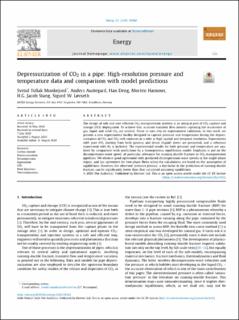| dc.contributor.author | Munkejord, Svend Tollak | |
| dc.contributor.author | Austegard, Anders | |
| dc.contributor.author | Deng, Han | |
| dc.contributor.author | Hammer, Morten | |
| dc.contributor.author | Stang, Hans Georg Jacob | |
| dc.contributor.author | Løvseth, Sigurd Weidemann | |
| dc.date.accessioned | 2021-08-19T12:13:08Z | |
| dc.date.available | 2021-08-19T12:13:08Z | |
| dc.date.created | 2020-09-01T09:27:52Z | |
| dc.date.issued | 2020 | |
| dc.identifier.issn | 0360-5442 | |
| dc.identifier.uri | https://hdl.handle.net/11250/2770324 | |
| dc.description.abstract | The design of safe and cost-efficient CO2-transportation systems is an integral part of CO2 capture and storage (CCS) deployment. To achieve this, accurate transient flow models capturing the occurrence of gas, liquid and solid CO2 are needed. These in turn rely on experimental validation. In this work, we present a new experimental facility designed to capture pressure and temperature during the depressurization of CO2 and CO2-rich mixtures in a tube at high spatial and temporal resolution. Experiments with pure CO2 starting from both gaseous and dense (liquid) states are presented, and a reference experiment with N2 is included. The experimental results for both pressure and temperature are analysed by comparison with predictions by a homogeneous equilibrium model. Emphasis is put on the decompression-wave speed, of particular relevance for running-ductile fracture in CO2-transportation pipelines. We observe good agreement with predicted decompression-wave speeds in the single-phase region, and fair agreement for two-phase flows when the calculations are based on the assumption of equilibrium. However, the observed ‘pressure plateau’, a key factor in the prediction of running-ductile fracture, can be significantly lower than that calculated assuming equilibrium. | en_US |
| dc.language.iso | eng | en_US |
| dc.publisher | IEEE | en_US |
| dc.rights | Navngivelse 4.0 Internasjonal | * |
| dc.rights.uri | http://creativecommons.org/licenses/by/4.0/deed.no | * |
| dc.title | Depressurization of CO2 in a pipe:High-resolution pressure and temperature data and comparison with model predictions | en_US |
| dc.type | Peer reviewed | en_US |
| dc.type | Journal article | en_US |
| dc.description.version | publishedVersion | en_US |
| dc.rights.holder | The Authors | en_US |
| dc.source.volume | 211 | en_US |
| dc.source.journal | Energy | en_US |
| dc.identifier.doi | 10.1016/j.energy.2020.118560 | |
| dc.identifier.cristin | 1826369 | |
| dc.relation.project | Norges forskningsråd: 257579 | en_US |
| dc.relation.project | Norges forskningsråd: 225868 | en_US |
| dc.source.articlenumber | 118560 | en_US |
| cristin.ispublished | true | |
| cristin.fulltext | original | |
| cristin.qualitycode | 2 | |

